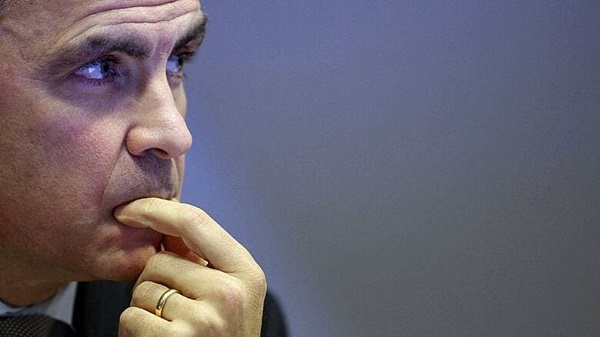Environment
Journalism Misrepresent Climate Science

From EnergyNow.ca
By Jim Warren
So-called “climate realists” including , Bjørn Lomborg, have long held that climate activists and journalists exaggerate and misrepresent the threat presented by climate change.
In the latest edition of his book, False Alarm: How Climate Change Panic Costs Us Trillions, Hurts the Poor, and Fails to Fix the Planet, Lomborg muses, “Recently the media has [mis] informed us that humanity has just a decade left to rescue the planet, making 2030 the deadline to save civilization.”
This column proposes that the milieu of media hyperbole and fear that Lomborg describes has indeed contributed to the overly zealous climate change policy regime the federal government is imposing on western Canada’s agriculture and energy industries.
One of the clearest examples of media and activist misinterpretations of climate science involves the 2019 release of the Intergovernmental Panel on Climate Change (IPCC) Special Report on Climate Change and Land (SRCCL). The report’s release launched a flurry of wildly inaccurate mainstream media stories and social media posts that misrepresented its actual contents.
My initial interest in the report on land and climate change was influenced by the fact a colleague of mine at the University of Regina was one of the scholars selected by the IPCC to help produce it. And, given that the report would be addressing land use, food production and food security, I assumed it would likely have things to say that were relevant to agriculture in Saskatchewan.
Work on the SRCCL began in April of 2016. It was one of three special reports that would be incorporated into the IPCC’s Sixth Assessment Report, set for release in 2021. (The IPCC has been publishing Assessment Reports once every four to five years since 1988. They are its principal vehicle for presenting an overview of scientific assessments of climate change to the world.)
The mandate of the special report on climate and land was to explore the relationships between land use, land degradation, desertification, deforestation and climate change as well as the impacts of those relationships on global food security.
The executive summary for the report was released on August 8, 2019 at a news conference held in Geneva, Switzerland. I made a point of reading the summary the day it was released because I hoped to refer to it in an informed way the next time I met next with my colleague. (The IPCC refers the executive summary as the Summary of Policymakers).
By the evening of August 8, the distortion of reality was already underway. I encountered a number of the media stories describing the report that had little or nothing to do with the 107 findings and recommendations that appear in the Summary for Policymakers. Many of the stories led with the assertion that the report’s key message was the need to limit red meat consumption. According to my reading of the report this was patently incorrect—reducing red meat consumption was not a central theme of the report.
The journalists responsible for some of the stories were mistaken, or worse yet, making up things. As it happened, a number of climate scientists also recognized the disconnect between what the media were saying about the report and what the report actually said. In August 2021, the academic journal, Climate Change, published an article by Oxford University academic Mary Sanford and three co-authors about the controversy surrounding the way traditional media and activists on Twitter had characterized the report.
Sanford and her co-authors report that “five UK-based media organizations whose websites are amongst the most used and trusted led their coverage on the SRCCL with a focus on eating less meat in their headlines.”
The offending UK media outlets included the BBC, The Telegraph, The Mail, The Times and The Independent. Sanford’s group gave special mention to “The BBC’s article on 8 August headline ‘Plant-based diet can fight climate change – UN’.” The global reach of inaccurate coverage was bolstered by the London-based Reuters news agency which “led one of its main articles on the SRCCL with the headline ‘U.N. flags need to cut meat to curb land use impact on global warming’.”
In the U.S., articles in Time magazine, the Wall Street Journal and Vox all led with comments critical of the climate effects of meat eating or other negative aspects of the meat industry.
The headline for the August 8 CBC story on the report read, “Farming and eating need to change to curb global warming.” Although, in the body of the story itself dietary change doesn’t come up until the third paragraph and meat consumption is not specifically mentioned.
Some traditional media organizations did better. Fox News, The New York Times, and The Washington Post ran articles that addressed the report’s principal themes such as the bidirectional effects of land use practices on the climate and the impact of a changing climate on the sustainability of land use practices and the global food supply. Some like CNN provided reasonably accurate coverage in their initial August 8 reports but in subsequent days gave dietary change greater attention.
Contrary what many of the media reports suggested, several of the findings and recommendations in the Summary for Policymakers actually recognize the importance of well-managed livestock grazing to sustainable food production and biodiversity. One of the findings indicates that grazing lands provide habitat for a far greater range of plants and animals than annual field-crop agriculture. Another finding notes the carbon sink value of grassland. One of the findings regarding diet notes the important role animal protein plays in the food system. Another point recommends diversity in diets and the beneficial role played by public health dietary guidelines. At the same time the report does acknowledge that ruminant livestock (cattle, bison, sheep and goats) produce methane emissions that contribute to the greenhouse effect. But according to the report that fact does not mean we need to cease raising ruminants for food.
One needs to dive much deeper into the 910 page report than the executive summary to find any discussion about the effects of meat consumption on the climate or the food supply. In Chapter 5 the report surmises that if everyone on the planet ate as much beef as the average resident of the UK, 95% of the world’s agricultural land would be required to support meat production. And, it mentions there is academic literature which recommends reducing the consumption of animal food products while increasing the proportion of plant-based food in diets.
Chapter 5 also has a paragraph that suggests red meat consumption could potentially be reduced with the development of plant-based meat substitutes. And, in case you were wondering where Prime Minister, Justin Trudeau and the environment and climate change minister, Steven Guilbeault, get some of their more novel ideas, there is indeed a sentence in the report that suggests we might be able to make greater use of insects for food. Yep, you read that right. Buried in Chapter 5, a single sentence on insect eating is presented as a sort of blue sky idea that might help reduce red meat consumption.
It is safe to say consumption of red meat was not a significant theme in the report and eating meat was not categorically condemned. The report supports well-managed sustainable livestock grazing and recognizes the dietary importance of red meat.
As one might expect, news reports focusing on diet and meat consumption were condemned by agricultural organizations such as the UK’s National Farmers’ Union. The tenor of the news stories was also a cause of alarm for the IPCC. I met with my colleague the week of the report’s release and asked her if the IPCC was aware of the distortions in the media coverage. She said that they were and acknowledged it was a problem since the media’s focus on diet and red meat detracted from their efforts to have the actual findings of the report publicized.
No less important than identifying the inaccuracies in the news stories about the SRCCL is understanding how and why the reporting was so bad. There are a number of possibilities. One is that many journalists were simply too busy or too lazy to actually read the Summary for Policymakers before writing their stories. We might also suspect many relied on their personal world-views and preconceived ideas about what they thought they should say. Worse yet they might have actually read the report and intentionally misrepresented its contents. A good follow up question might be what are the origins of journalists’ established views on climate change and meat consumption?
Sanford and her co-authors make an effort to get at these questions and propose that many journalists’ mindsets are influenced by social media. They suggest the January 2019 release of a report published by the EAT-Lancet Commission was still fresh in many journalists’ minds when they wrote about the SRCCL in August that same year. The EAT-Lancet report was produced by 37 scientists in association with the medical journal, The Lancet, and promoted itself as “the first full scientific report of what constitutes a healthy diet from a sustainable food system that can support and speed up food system transformation.” (By way of comparison the SRCCL report was generated by 330 scientists and social scientists – more than 1,500 scientists contribute to the IPCC Assessment Reports).
The EAT-Lancet report does indeed recommend a reduction in global meat consumption. It is noteworthy that it does not advocate for the end of meat and dairy consumption but does support vegetarianism and veganism.
The EAT-Lancet report states: “The planetary health diet is a global reference diet for adults that is symbolically represented by half a plate of fruits, vegetables and nuts. The other half consists of primarily whole grains, plant proteins (beans, lentils, pulses), unsaturated plant oils, modest amounts of meat and dairy, and some added sugars and starchy vegetables. The diet is quite flexible and allows for adaptation to dietary needs, personal preferences and cultural traditions. Vegetarian and vegan diets are two healthy options within the planetary health diet but are personal choices.”
According to Sanford and her co-authors, the publication of the EAT-Lancet report coincided with growing interest in veganism and the popularization of “reports associating meat eating and livestock farming with a range of negative impacts, particularly on GHG (methane) emissions.”
By the time the IPCC released its SRCCL report the EAT-Lancet report had generated over eight million Twitter posts. While the reaction on Twitter was divided between supporters and opponents of vegetarianism, the participation of anti-livestock vegan and vegetarian activists was clearly influencing the discussion. Sanford and company propose that views critical of meat consumption were likely shaping the attitudes of journalists.
A number of studies have described the symbiotic relationship that exists between journalists and Twitter. Journalists use Twitter to post comments and links to their own stories. They also use it to inform the news stories that they write. Furthermore, journalists constitute the largest user category on Twitter, accounting for 26% of the platform’s verified accounts. Journalists and news organizations are frequent tweeters. A 2022 article in Editor and Publisher, an online publication, states that 70% of journalists claim Twitter is the first or second social media site they use most frequently in their jobs. They make posts about the content they produce and have more followers than any other verified user groups on Twitter.
In 2018, an article in the Columbia Journalism Review expressed alarm over the reliance journalists were placing on Twitter as a source for their work. Especially worrisome was the fact some journalists claimed to place more reliance on anonymous tweets than information provided by The Associated Press. The quality of journalism is bound to suffer if reporters rely on the claims of activists with agendas that don’t include dissemination of unvarnished objective evidence. The danger is that this can produce a cycle of garbage in garbage out journalism.
We can reasonably assume that at least some journalists writing articles in the week following the release of the SRCCL were influencing the discussion on Twitter and were in turn influenced by it. However, the data presented by the Sanford group also suggests that journalist-Twitter cross fertilization was occurring in only two corners of the Twitterverse.
It is hardly surprising that the research shows when it comes to issues related to the IPCC and climate change, social media posts reflect the culture wars occurring in wider society. Social media posts about climate change occur within two polarized echo chambers. There is the activist group who embrace the idea that climate change is a real and urgent problem threatening life on the planet. Some members of the activist faction claim climate change is the greatest threat facing humanity and nature. And, then there is the skeptic faction that includes those who claim the science on climate change is uncertain and the dangers are frequently exaggerated. And, it’s true some members of the skeptic group assume human caused climate change is a hoax.
Social scientists often feel the need to invent jargon to describe social phenomena. One of the concepts they use to explain the climate divide on Twitter is “homophily,” the tendency for people to be attracted to and seek out others who are similar to themselves – and share their opinions. Added to this is “confirmation bias,” the tendency of people to accept new information when it confirms their pre-existing beliefs and reject ideas that contradict those beliefs.
Sanford and her co-authors systematically parsed over 6,000 Twitter posts related to the SRCCL. They show that most of the discussion on Twitter was indeed contested by the usual suspects. There was a skeptic camp who criticized the IPCC “for in their view slandering the meat and dairy industries, and trying to take away their right to eat meat.” And there was an activist group, which included vegans and vegetarians who criticized meat eaters for contributing to climate change.
Given the actual content of the Special Report on Climate and Land, the content of the Twitter war makes absolutely no sense. The skeptics were incensed over things the report never actually said and the activists defended it for things it didn’t actually say. Particularly troubling for people who hope for objective unbiased reporting is that journalists tended to side with the inaccurate assessments being made by the activist camp. As we’ve seen, many of them wrote stories that identified diet and meat eating as the focus of the report. Both vegan activists and sympathetic journalists would have come closer to “their own truth” had the news stories criticized the IPCC for failing to pay enough attention to diet and meat eating.
It is disturbing to learn objective reality had such a minimal impact on the Twitter debate or the journalists writing inaccurate stories. It was a case of homophily and confirmation bias on steroids. People simply chose sides based on their usual positions regardless of actual facts and evidence. It was wearing the team colours that really counted.
For people who rely on agriculture or jobs in the energy sector for their livelihoods the current quality of media articles and discussions on social media in relation to climate change is not very comforting. In Canada, the problems may well be exacerbated by the federal government’s subsidization of traditional media organizations. The agendas of strident environmental activists and the federal government’s climate policies often coincide. Given the incestuous relationship between journalists and environmental activists on Twitter it is perhaps understandable that traditional media, environmental activists and the federal government often sing from the same hymn book. For people who practice healthy skepticism, the fact our federal government is subsidizing the news media is grounds for suspicion about the veracity of Canadian journalism.
Unfortunately coming up with effective strategies for combating widely-held misconceptions about climate change in traditional and social media is a daunting challenge. The problem is unlikely to be remedied any time soon.
Jim Warren is an Adjunct Professor and Lecturer in environmental sociology at the University of Regina.
Environment
EPA releases report on chemtrails, climate manipulation

Quick Hit:
The Environmental Protection Agency under Administrator Lee Zeldin has released new online resources addressing public concerns about geoengineering and contrails. Zeldin stated the EPA is committed to transparency, publishing everything it knows about these controversial topics.
Key Details:
- New EPA Pages: Explain the science of contrails and debunk “chemtrail” claims, while outlining potential risks of solar geoengineering.
- Zeldin’s Statement: “Americans have legitimate questions… they deserve straight answers,” noting EPA’s concerns about geoengineering health and environmental risks.
- Legislative Context: Rep. Marjorie Taylor Greene plans to introduce a bill banning atmospheric chemical dispersals for weather modification purposes.
The Trump EPA is committed to total transparency. I tasked my team @EPA to compile everything we know about contrails and geoengineering to release to you now publicly. I want you to know EVERYTHING I know about these topics, and without ANY exception! https://t.co/izKBz0lFvr pic.twitter.com/FkOCgBm3K9
— Lee Zeldin (@epaleezeldin) July 10, 2025
Diving Deeper:
The Environmental Protection Agency on Thursday launched two detailed online resources aiming to give Americans what Administrator Lee Zeldin described as “total transparency” on contrails and geoengineering. In a video message, Zeldin said the pages were designed for “anyone who’s ever looked up to the streaks in the sky and asked, ‘What the heck is going on?’”
The EPA’s contrail page clarifies that condensation trails are a normal byproduct of jet aircraft exhaust, akin to car exhaust being visible on a cold day. The agency directly addressed claims that these are “chemtrails” — alleged intentional chemical releases for nefarious purposes like population control or weather modification — stating there is no evidence the federal government has ever used contrails to geoengineer or alter weather.
However, the agency acknowledged the reality of solar geoengineering research, particularly stratospheric aerosol injection (SAI), which aims to reflect sunlight to cool the planet. Zeldin noted that enthusiasm for such experiments has “set off alarm bells” within President Trump’s EPA, as the practice could deplete the ozone layer, damage crops, alter weather patterns, and create acid rain.
Currently, only one private U.S. company, Make Sunsets, has experimented with SAI and marine cloud brightening, though these remain in early research phases. Meanwhile, traditional weather modification, such as cloud seeding, has been conducted at state or local levels to alleviate droughts, not to control climate or populations.
The EPA also highlighted past U.S. government weather modification projects, including Operation Popeye during the Vietnam War, which attempted to extend the monsoon season to disrupt enemy supply lines. Some states, like Florida and Tennessee, have since passed laws banning geoengineering or weather modification without explicit approval.
Rep. Marjorie Taylor Greene (R-Ga.) recently pledged to introduce federal legislation criminalizing any injection or dispersal of chemicals into the atmosphere to alter weather or climate. Zeldin concluded that the EPA shares Americans’ concerns over geoengineering’s risks and emphasized that this marks the first time the agency has proactively addressed such public fears in this way.
Energy
B.C. Residents File Competition Bureau Complaint Against David Suzuki Foundation for Use of False Imagery in Anti-Energy Campaigns

From Energy Now and The Canadian Newswire
A group of eight residents of Northeast British Columbia have filed a formal application for inquiry with Canada’s Competition Bureau, calling for an investigation into the David Suzuki Foundation’s (the Foundation) use of false and misleading imagery in its anti-energy campaigns.
The complaint alleges that the Foundation has repeatedly used a two-decade-old aerial photograph of Wyoming gas wells to falsely depict modern natural gas development in B.C.’s Montney Formation. This area produces roughly half of Canada’s natural gas.
Key Facts:
- The misleading image has been used on the Foundation’s website, social media pages, reports and donation appeals.
- The Foundation has acknowledged the image’s true source (Wyoming) in some contexts but has continued to use it to represent B.C. development.
- The residents claim this materially misleads donors and the public, violating Section 74.01(1) of the Competition Act.
- The complaint is filed under Sections 9 and 10 of the Act, asking the Bureau to investigate and impose remedies including ceasing the conduct, publishing corrective notices, and returning proceeds.
Quote from Deena Del Giusto, Spokesperson:
“This is about fairness and truth. The people of Northeast B.C. are proud of the work they do to produce energy for Canada and the world. They deserve honest debate, not scare tactics and misleading imagery used to raise millions in donations. We’re asking the Competition Bureau to hold the David Suzuki Foundation to the same standard businesses face: tell the truth.”
Background:
Natural gas development in the Montney Formation supports thousands of jobs and fuels economic activity across the region. Accurate public information is vital to informed debate, especially as many Canadians live far from production sites.
SOURCE Deena Del Giusto
-

 Business24 hours ago
Business24 hours agoMark Carney’s Fiscal Fantasy Will Bankrupt Canada
-

 Business2 days ago
Business2 days agoCarney government should apply lessons from 1990s in spending review
-

 Entertainment2 days ago
Entertainment2 days agoStudy finds 99% of late-night TV guests in 2025 have been liberal
-

 Alberta23 hours ago
Alberta23 hours agoTemporary Alberta grid limit unlikely to dampen data centre investment, analyst says
-

 Opinion1 day ago
Opinion1 day agoCharity Campaigns vs. Charity Donations
-

 Frontier Centre for Public Policy2 days ago
Frontier Centre for Public Policy2 days agoCanada’s New Border Bill Spies On You, Not The Bad Guys
-

 Daily Caller19 hours ago
Daily Caller19 hours ago‘Strange Confluence Of Variables’: Mike Benz Wants Transparency Task Force To Investigate What Happened in Butler, PA
-

 Uncategorized2 days ago
Uncategorized2 days agoCNN’s Shock Climate Polling Data Reinforces Trump’s Energy Agenda




